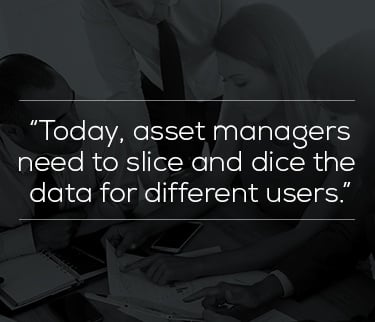The middle office was once tasked solely with processing front office data. Not anymore.

Today middle office teams are not only expected to feed into execution and settlement processes.
They also need to service the demands of the sales team, the risk and regulations teams, and contribute to the wider strategic servicing ability of the asset management firm as a whole.
In effect, the data produced by the middle office has external clients (investors and the regulator) and internal clients (risk and compliance, sales and marketing, strategic insight), all with different requirements.
Changing market structure
Gert Raeves, Research Director at CEB TowerGroup says: “The market structure has changed to the extent that the middle office is not just a support function any more.
“It is also a stand-alone unit that deals with internal risk management and regulatory compliance. It needs to produce reports for many more ‘clients’ than just the front office and it also has a plethora of investments to report on, all with their own data types.”
{{cta(‘ca84c1e0-b365-4c2f-85c2-37795924b4ee’)}}
These changes are largely down to the regulatory tsunami that came as a result of the 2008 crisis. The focus of the regulation is on transparency and better risk management so that firms and the regulator are able to see their overall risk position and act accordingly.
According to this report by PwC, regulations have “all placed greater demands on asset managers and their service providers – forcing changes in fund product features, service provider arrangements, regulatory and investor disclosure, distribution channels, compliance and risk management functions, etc. – and in some cases forcing revision of business models.”
“Regulators are turning their attention to asset managers, scrutinizing their culture, interactions with customers and effectiveness in implementing required regulatory changes.”
Who are the new users of data?
The data that comes from this is used not just by the regulator and the risk control team but also by a host of other ‘consumers’. The data and reports that the middle office produce are also used to analyze overall performance, work out what is and isn’t working for the asset manager and inform future strategy.
As a result, a recent white paper by Deloitte and Swift suggests data governance should cover all the main stages of the life cycle, including:
- Data sources
- Data collection and control
- Shaping the data
- Reporting
- Monitoring data quality
- Data archiving.
This, the authors say, leads to effective data management and supports sales, execution, settlement, risk and regulations, and servicing.
However, being able to do this relies on having the right technology and analytics to be able to slice and dice the data effectively for different users. For many firms today, the answer is for the middle office to lock down a single “golden” copy of the data and then allow users to apply analytics to answer their own distinct questions.
Enabling the middle office to become a net contributor to the business
In a separate report by PwC the authors say: “Those who take steps now to right-source their middle office stand to create a powerful infrastructure that results in a competitive advantage—which, in turn, boosts the bottom line.”
By contrast, PwC claims an infrastructure that is inflexible and unscalable for product, customer, regulatory growth, and increasing product complexity needs re-examination.
Data types include: product/instrument, client/counterparty, book, market data, corporate actions and transactions and positions data. Correctly receiving and analyzing this data means that the demands of all users can be met.
To do this asset managers need to carefully identify the best operating model for their business. PwC characterizes the ideal middle office as a unit that:
- Is viewed as a strategic business partner
- Manages operational performance through the use of metrics
- Has proactive decision support
- Relies less on static data and more on accessibility of actionable information
- Can increase system integration capacity
- Is cost efficient and highly automated.
Adding to the bottom line ultimately relies on a powerful interdependent relationship between the data and the systems that it runs over. The report by Deloitte, mentioned above echoes this conclusion by exploring the linkage between data governance at all stages of the lifecycle and how that filters down to the various data types and the way they are used and supported firm wide.
In other words, having good linkage and an understanding of the way the data and systems work together is key to gain or maintain future competitive advantage.
Takeaways:
- The middle office serves the front office, the regulator and internal consumers of its data.
- Regulation has meant the amount of data produced has increased.
- That data can be used to effect strategic decision making as well as inform the regulator and internal compliance.
- Doing so relies on systems being able to produce meaningful versions of the same data, reworked for each end user.
{{cta(‘011c29b4-cf40-446b-8c62-0e75365ff77f’)}}